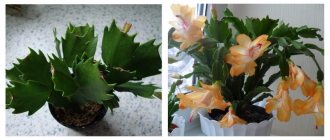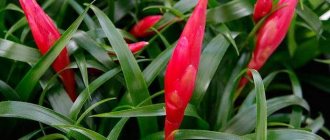Variety of plant names
It’s true, they say that the new is the well-forgotten old! The rare Brazilian marica plant, whose care at home raises many questions among owners today, was a very common flower in the second half of the last century, and it could be seen in almost any institution. Canteens, school classrooms, hospital corridors - these are the places where neomarica grew quite successfully.
And the name has undergone a change: known as morea, then marika, and now called neomarika. Obviously, "neo" as a complement explains the origin of the plant, pointing to the "New World", that is, America. But this plant is popularly known by other names: • “Apostolic plant.” According to legend, it begins to bloom when it produces 12 (the number of apostles) leaves that gently frame a pale lilac flower. • “Walking or crawling iris.” The children, located at the ends of the leaves under their own weight, sink to the ground and take root. Due to movement in this way, neomarica - the walking iris - got its name. • "Devil's Paw." Sprawling, fan-shaped greenery with pointed leaves up to 80 cm long with daughter racemes on each gives the impression of a shaggy paw.
Reproduction methods
To get a new plant, several methods are used. The simplest is considered to be planting baby shoots.
The procedure consists of the following steps:
- Cover the bottom of the pot with a drainage layer.
- Fill the container with substrate.
- Attach a bent peduncle with a daughter rosette located at the top to the soil with wire or a regular hairpin. Sprinkle with a little soil.
- Rooting takes 7-20 days.
- After the specified time, the peduncle must be cut off.
Note!
A plant grown in this way blooms in the second year.
The next propagation method is dividing the mother bush. It is used if several leaf rosettes have formed on an adult specimen:
- Remove the flower from the flowerpot. Free from the land coma.
- Using a well-sharpened knife, divide the neomarica roots into several parts. Each division should have 3-4 growth points.
- Treat the cut areas with sulfur, crushed charcoal or activated carbon.
- Plant in individual pots with soil and good drainage.
A less effective and rather complex method is seed propagation. The collected material loses its viability after just a few months:
- Fill the container with a damp mixture of peat and sand. Level the surface.
- Sow the seeds.
- Cover the bowl with glass or plastic film to create greenhouse conditions.
- Provide bottom heating. To do this, you can place a vessel filled with warm water under the container.
- Systematically ventilate and moisten the soil with a spray bottle as it dries.
- After 14-20 days, the first shoots will appear.
- After the formation of 2-3 full-fledged leaf plates, dive into individual flowerpots.
Important!
It is worth preparing for the fact that only half of the seeds will sprout.
Neomarika has a strong immune system and gets sick extremely rarely. But despite this, errors in care can cause the following problems:
Root rot. The main reason is excess moisture in the substrate. For treatment, it is necessary to remove the bush from the flowerpot, remove the affected areas, and treat with an antifungal drug. Sprinkle the cut areas with crushed activated charcoal or charcoal. Replant into a previously disinfected pot and soil. Yellowing and drying of leaves. The provoking factor is exposure to direct sunlight. To save the plant from burns, you should move it to a more suitable place or shade it during periods of high solar activity (from 11 a.m. to 4 p.m.). Brown spots appeared on the tips of the plates, and gradual drying began. The reason is dry air. Spraying needs to be adjusted. Lack of flowering. There is an opinion that neomarica produces buds only when 12 full-fledged leaf blades are formed on it. Hence another name for the plant – “apostolic flower” (based on the number of apostles). If this does not happen, the reason for the lack of buds may be a lack of light, winter “rest” spent at high temperatures, or excessive soil fertilization. To get rid of this problem, you need to eliminate the cause
It is important to remember that the formation of flower buds occurs in winter, at reduced temperatures and sufficient light. In addition, you should not be overzealous with fertilizing. Due to excessive dry air, the walking iris can be attacked by spider mites or aphids
The first step in pest control is washing the leaves with a solution of laundry or tar soap. Then, it is necessary to treat the bush with insecticides.
Interesting!
Detailed information about the herbaceous perennial, as well as recommendations from experts, can be viewed in the video.
Neomarica is a fairly unpretentious plant and care at home is minimal. To enjoy the beauty of magnificent fan leaves and the exotic charm of flowers, it is enough to adhere to basic rules and create a microclimate suitable for development.
Description of the plant
Neomarica slender is more common in home collections. The flower is distinguished by sword-shaped leaves, the length of which reaches 1 m with a width of 6 cm.
A flowering arrow up to 1.5 m long produces flowers that, when opened, resemble traditional irises, which bloom only for one day and give those around them a striking aroma. On each peduncle, up to 10-12 flowers up to 10 cm in size bloom one after another. Each of them is allocated one day so that others can enjoy their view.
On the dried formation there is a daughter shoot, which then takes root in the soil, allowing the plant to “move.” It is this feature that is noted in one of the options for the name of the flower. Walking neomarika (photos of which are presented in the article) will decorate the interior of any room.
What are the types of neomarica?
Neomarica slender belongs to the herbaceous flowers. The leaves are arranged in a semicircle and have a greenish tone. Their length is 40-60 centimeters, width up to five centimeters. The peduncle includes up to 10 colors, each 6-10 centimeters in diameter.
With its flowering, neomarica pleases only during the day. So, with sunrise, the bud opens, shows its beauty during the day, and withers completely in the evening.
Neomarica northern belongs to has thin and strong leaves up to 90 centimeters long and up to five centimeters wide. The flowers reach up to ten centimeters in diameter. Their shade is lilac, in some cases with a blue tint. The flowers are fragrant.
Planting, soil features
In order for neomarika to be pleasing to the eye, care at home must be appropriate. Knowing the original principle of flower propagation, you need to take care of planting. Small roots allow you to choose a shallow but voluminous wide pot, convenient for the creeping root system of the plant, preferably made of ceramic.
In order for neomarica to grow well, no special care is required, but watering must be plentiful, so a good drainage layer is necessary. The bottom is covered with crushed bricks, clay shards, expanded clay granules, pieces of foam plastic - whatever is at hand. The composition of the soil for planting is selected in equal proportions of peat, sand and greenhouse soil. This composition provides loose soil, ideal in terms of nutritional composition for the plant. Coniferous mulch is sprinkled on top to prevent the soil mixture from drying out.
Growing and caring for neomarica flowers at home
Neomarica flower photo at home
Choice of location and lighting
Place neomarika on windows of eastern, western or northern orientation. The sun's rays leave burns on the leaves, which negatively affects the appearance - the plant is shaded from the bright midday rays.
Air temperature
Neomarica develops well at normal room temperature, and its natural decrease in winter is beneficial to the flower and serves as the key to bright flowering.
Watering and spraying
Spraying, especially at high indoor temperatures, has a positive effect on the condition of the flower. He also benefits from a warm shower at any time of the year.
Water for irrigation is used soft - melted, boiled. Watering depends on the time of year: in summer it is more plentiful and frequent, in autumn it is reduced, and in winter it is minimized, giving neomarica a dormant period of at least 2 weeks. Cool wintering guarantees lush and abundant flowering. The constant high temperature of the content leads to the fact that neomarica refuses to bloom. Move it as close to the glass as possible - this will be enough to admire the flowering.
Priming
The composition of the soil mixture is not particularly important - any universal soil from the store will do. She does not like fatty soils, because... in nature it grows on poor substrate. You can add a small amount of pine soil in the form of mulch. It is better to choose a ceramic pot - it is heavier, this will prevent the flower from falling on its side.
Feeding
For this reason, it requires almost no feeding; only at the beginning of active growth is it recommended to feed it with liquid complex fertilizer. Overfed neomarica blooms reluctantly or does not produce a peduncle at all.
How to care for neomarica
How to care for neomarica flower at home
In the summer, it is preferable to take the pot with neomarica out into the garden or onto the balcony, not allowing the soil to dry out, protecting it from the scorching sun and cold wind.
If necessary, trim off dried leaves. If you do not want to propagate the plant, cut off the faded flower stalks without allowing shoots to form, because this significantly weakens the mother bush.
If the neomarica doesn’t like something during budding, it may not open the flowers - they will immediately turn into babies.
Transfer
Young plants are replanted every year using the transshipment method - without disturbing the earthen coma, slightly enlarging the pot and adding a small amount of fresh soil. Older plants are replanted less often. If you use too large a container when replanting, the plant may not bloom until its roots fill the volume provided to it. The pot for planting is chosen wider than its height. Drainage at the bottom of the flowerpot is necessary for the timely drainage of excess liquid.
Favorable conditions
In care, much depends on what the owner expects from the plant: luxurious greenery or lush flowering? After all, it is not only the original flowering that attracts florists to neomarica. Care at home, organized in the right way, allows you to grow a green fan, which will become an indispensable backdrop for decorating your space. Therefore, we should clearly know what we want to get from the flower of the apostles, and based on this, the proper conditions created for the plant will be adjusted.
Neomarica: care at home
The walking iris does not require special attention, but this does not completely negate preventive procedures. The abundance of flowering depends on proper care.
Watering
The plant crop needs regular moisture, so it needs to be watered every 2-4 days in the summer. With the onset of cold weather, the frequency of procedures can be reduced to 1 time per week.
Humidity
For stable development of the crop, average air humidity in the room is required. The optimal indicator for caring for neomarica is up to 65%. This approach will provide normal conditions for the development of inflorescences and prevent the formation of fungus on them. In summer, when it is hot outside, it is recommended to irrigate the leaves of the plant with water. This will help maintain a stable humidity level. In winter, such procedures are not carried out.
The soil
Walking neomarica for home cultivation is considered an unpretentious plant. This applies to both the choice of soil for planting and the room, location and lighting. Experienced gardeners recommend planting it in a special mixture, sold in any flower shop. It contains all the necessary components for normal development.
Important! When preparing yourself, it is better to choose black soil diluted with humus, peat or river sand
Temperature
In order for neomarika to bloom well in the spring, it needs to be provided with a fairly cool winter. Optimal indicators for this period are 5-8 °C. It is better if the plant is in a lighted room.
Flower near the window
In summer, an acceptable temperature is 23 °C. At elevated rates, flowering may slow down.
Lighting
Gardeners recommend placing a pot of iris in well-lit rooms. This will help the flower bloom faster
Particular attention should be paid to light in winter. If there is no bright room, you can use special lamps
Features of watering
The plant was named after the river nymph Marika for good reason.
Neomarika (photos for reference are provided in the article) is an unpretentious flower, but loves moisture. In summer, iris requires abundant watering, which is reduced in the autumn-winter period by drying out the earthen lump under the plant. For irrigation, settled soft water is used; rainwater is perfect. Twice a month, when watering, it is necessary to add a few drops of lemon juice or citric acid crystals to avoid alkalization of the soil. After flowering, the plant needs two weeks of rest; watering stops during this period.
Air humidity is maintained at an average level during hot weather by spraying, and during the heating season by periodically showering the plant.
Possible difficulties
Neomarica is resistant to diseases. One popular pest is the spider mite. The threat of its occurrence increases when kept in dry air conditions. The pest is detected by the appearance of a thin cobweb on the edges of the leaves and multiple “punctures” along the surface of the leaf.
There is no delay in processing - the flower is bathed in the shower and thoroughly washed with a soapy substance. It is recommended not to limit yourself to available means. It is preferable to spray the plant with a different insecticide for house plants. Regular stagnation of moisture in the soil leads to the formation of root rot. The condition becomes more complicated at low temperatures. The flower is removed from the pot and cleaned from the soil. All damaged roots are trimmed and treated with fungicides. Planted in new sterile soil.
The lack of flowering indicates a lack of light or a lack of dormancy. The development of flower buds occurs in winter. During this period, lower temperatures and active lighting are necessary. Otherwise, it is an undemanding plant. All that is necessary from the gardener is to guarantee her lighting and carefully monitor the level of moisture.
About the author: Victoria Semyonovna Nakhodkina
Leading researcher at the laboratory of vegetable and berry crops, Yakut Scientific Research Institute of Agriculture, Siberian Branch of the Russian Academy of Agricultural Sciences, Republic of Sakha (Yakutia).
Lighting and temperature
Windows facing west and east are selected - it is on them that the neomarika will feel good. Home care that provides the plant with soft light will have a beneficial effect on the appearance of the flower. It will not tolerate overheating, so it is worth protecting the flowerpot from scorching sunlight, but the room should be bright. In winter (October - February) it simply needs coolness. The flowerpot can be moved to the glass on the windowsill or moved to a bright room with an ideal temperature of 10 C, for which the plant will respond with grateful flowering in the spring.
Description of the culture and main types
The perennial's homeland is the dense, wild forests of South and Central America, Costa Rica, and Colombia. The leaves are xiphoid, flat, leathery, collected in a fan. The maximum length is 150 cm, the width is 5-6 cm, textured veins are clearly visible on the surface.
A peduncle extends from the thickness of the plate, on which from 3 to 5 buds simultaneously bloom, reaching a diameter of 5 cm. They have a snow-white color, sometimes with a subtle note of ivory, the throat is decorated with veins of a light blue hue, and they emit a pleasant, fragrant aroma. Unfortunately, the allure is short-lived. The buds stay on the peduncle for only 24-48 hours. In their place a small rosette (baby) is formed.
Only a few types of perennials are grown as indoor crops:
- Neomarika is slim. Leaves of a rich green hue grow up to 50-60 cm. Up to 10 buds appear on the peduncle, but each blooms at a different time. In the morning, with the first rays of the sun, they open up, intoxicate with their aroma and beauty throughout the day, and fade in the evening. The lower lobes are snow-white, the upper part of the perianth is decorated with a bluish-sapphire feathery ornament. Closer to the base, each petal is “marked” with transverse intermittent stripes of carmine brown and yellow.
- Neomarica northern. The plates are flat, dense, reaching 90 cm in length. The violet-lilac (sometimes with a blue tint) flowers are large, about 10 cm in diameter, and have a strong but pleasant aroma. At the base of the petals, a transverse yellow-brown ornament is clearly visible.
- Neomaric Karuleya. Refers to ampelous plants. The flower reaches 10 cm in diameter. It shimmers in all shades of blue and indigo. At the base, the petals are “decorated” with a brownish ornament with an amber tint.
- Neomarica variegata. A characteristic feature is the variegated colors of the leaves. Lighter yellow-green longitudinal stripes clearly stand out against the emerald background. New buds form after the opened flowers wither.
Interesting!
Neomarica earned the second name “walking iris” due to one unusual property. The peduncle emitted by the plant stretches up to 150 cm, and after the buds wither, a baby forms at its tip. It develops, increases in size, becomes heavier and bends part of the mother stem to the ground. After some time, the daughter rosette takes root and continues to exist as an independent plant.
Fertilizers and replanting
Growing wild on poor soils in the mountains of Brazil, neomarica tolerates unfavorable environmental conditions well. Care at home (photos of beautiful flowers beckon you to have the same miracle) allows for feeding.
Fertilizer is applied from May to July, during the flowering period. The plant loves fertilizing; it is applied twice a month, which stimulates the growth of abundant greenery in the flowerpot. This option is ideal for growing a luxurious “peacock tail” or “devil’s paw” in a short period of time. Fertilizer for orchids is suitable for this.
If not properly cared for, the apostolic flower can be affected by spider mites. If you “put the apostolic flower on a diet” by cutting back on fertilizing and watering, you can get a neat hanging plant without lush greenery. A young plant must be replanted every year in the spring, and adult specimens after 2-3 years, depending on the growth of the iris.
A flower that can decorate an interior either on its own or become a lush green background for other plants, is unpretentious, but will be able to reward you with the beauty and fragrance of original buds that will delight the eye and heart with their flowering. Get a walking iris in your home - you won't regret it!
Pests and diseases
This plant practically does not get sick and is rarely affected by insects. When the surrounding atmosphere is extremely dry, spider mites are likely to appear. If there is a thin web between the leaves, treat the flower with an appropriate insecticide.
If you do not want to use chemicals, a positive effect can be achieved if you give the plant a warm shower every day, thoroughly washing off all the leaves. Adding a small amount of laundry or tar soap to the water for washing the leaves will significantly enhance the effect of these procedures.
Neomarica leaves turn yellow
If the soil is over-moistened during wintering, root rot may appear, and neomarica leaves turn yellow.
- It is recommended to remove the neomarica from the pot, remove the affected areas of the roots, and sprinkle the remaining areas with charcoal or activated carbon.
- The plant is planted in a new pot with fresh disinfected substrate (you can water it with a phytosporin solution).
- Transplantation and root rot can be prevented by using sphagnum moss. Spread in a thin layer on top of the soil mixture, moss helps fight various scourges. It has high hygroscopicity and bactericidal properties, absorbs excess liquid, preventing the development of diseases. Moisture evaporating from the surface of the moss additionally humidifies the air near the flower.
Such a wonderful plant deserves more attention. Excellent bright malachite foliage cleanses the atmosphere of any room, looks great, perfectly decorates the interior, and brings a lot of positive emotions to its owners.











